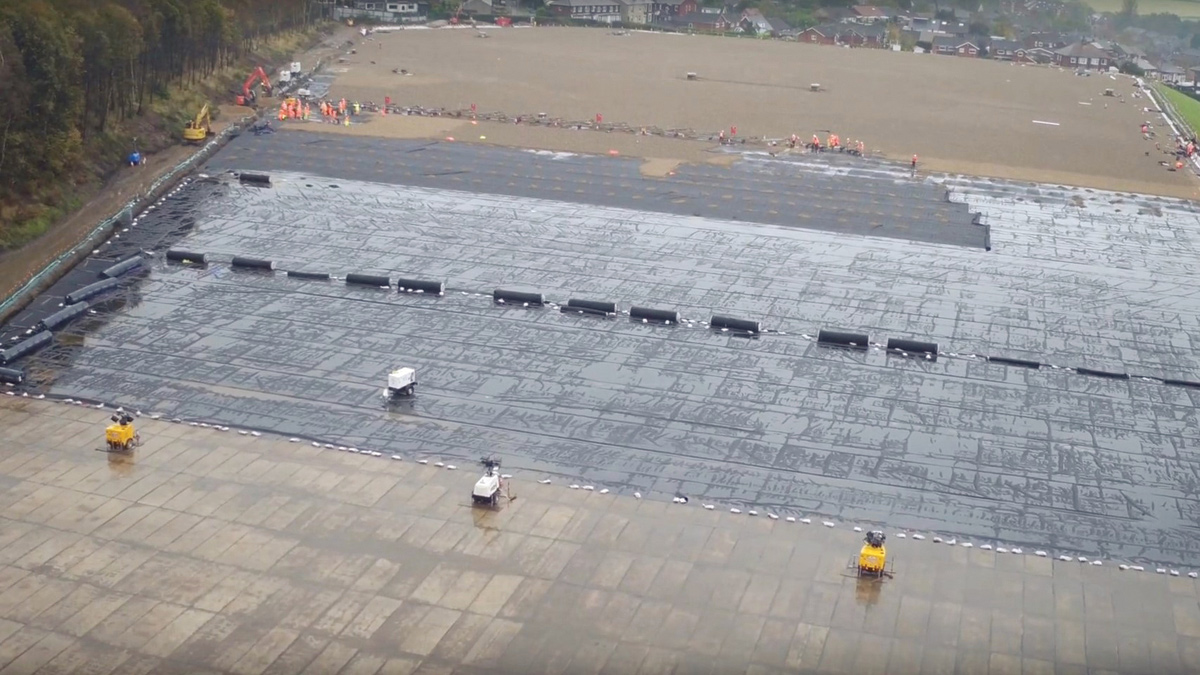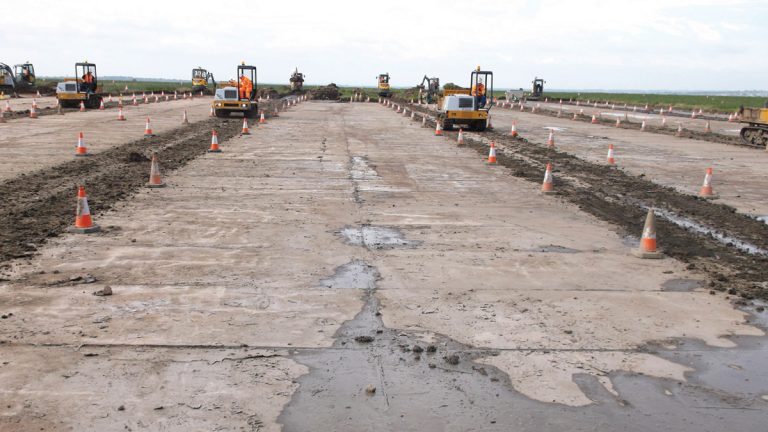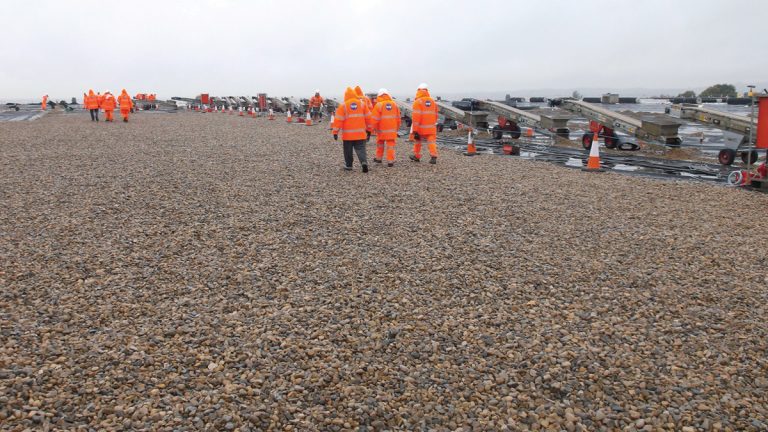Woodgate Hill Service Reservoir No. 2 (2018)

Woodgate Hill Reservoir - Courtesy of United Utilities
Woodgate Hill Service Reservoir No. 2 (SR2) was commissioned in 1963, providing a total capacity of 269Ml and a throughput that equates to 20% of the regional water demand. The reservoir was built in to the hillside with an excavation of around 380,000m3. With a footprint of 47,000m2, at the time of construction, Woodgate Hill SR2 was the largest single compartment reservoir in Europe, and is thought to be the second largest in its 55th year. Due to its capacity, the reservoir is subject to the Reservoir Act 1975. As such, a Section 10 periodic inspection is required by a qualified civil engineer. In the latest inspection, recommendations were made to consider the life of existing roof joints and the condition of the reservoir roof to provide security to the potable water supply.
Project scope
United Utilities (UU) appointed a £6.25m contract to Mott MacDonald Bentley (MMB) to provide supply resilience by installing a waterproofing layer to the existing precast roof, and covering with a low-maintenance, free-draining gravel overburden.
MMB worked with UU to undertake the installation of the largest intelligent leak-detection membrane over a service reservoir in the UK. The membrane from Sensor UK provides a waterproof protective layer above the existing reservoir roof with a real-time alarm system capable of pinpointing punctures to a 100mm2 GPS location, and is also able to raise alarms to the UU central control room, supported with additional mobile phone notifications.
The standalone system is designed to continually monitor the status of the multi-layer membrane through a network of sensors and electrodes, linked to a main control unit. The system continuously monitors the status of the membrane to determine anomalies in the otherwise stable system.
Reservoir construction
The roof of Woodgate Hill SR2 is constructed of 4.5m by 1.5m precast panels, spanning over a series of reinforced columns and beams. The precast panels are formed in a ribbed arrangement, reducing to 63mm thick at the centre, from 150mm at the perimeter.
The nature of the construction restricted the size of plant to be used for the overburden removal to 2.5 tonne tracked vehicles and prevented plant tracking across the mid-span of the panel.
All plant was required to work in designated lanes and remove existing overburden prior to tracking to the next slab. This efficient procedure was ideal for the use of multiple plant items, with 10 excavators and 10 tracked dumpers to remove the topsoil.
Throughout the project duration, the contractor continually monitored the concrete temperature using a non-contact infrared thermometer and undertook thermal imaging surveys inside the reservoir.
During reinstatement, to minimise unnecessary damage to the new membrane, MMB employed a system of conveyors teamed with an army of operatives and a fleet of 56 (No.) wheelbarrows to place 14,000 tonnes of clean, rounded gravel.

Traffic management – Courtesy of MMB
Construction works
Due to the critical nature of SR2, UU limited the duration of the reservoir outage to 16 weeks. In this time period it was necessary to remove over 17,000m3 of waterlogged topsoil, installing over 94,000m2 of HDPE membrane, 94,000m2 of conductive fleece, 47,000m2 protective geotextile and placing 7,000m3 of gravel.
Overburden removal began in August 2017 with rigorous approach to defined vehicle routes, designated topsoil storage area, demarcated working lanes and traffic management allowed for a controlled, safe and efficient working.
By September, a team of subcontract installers began the first phase of membrane installation. Utilising a loose laid membrane system permitted minimum preparation of the existing concrete roof and negated any remedial works to the existing precast panel joints, helping to deliver the project objectives within the timescales allowed. The nature of the membrane allows for quick installation, with the full system of membrane to be installed over an area of 47,000m2 in only 8-weeks, including over 1km of battening to the reservoir wall. The flexibility of the membrane continues to allow the reservoir to operate without the risk of settlement or expansion rupturing the waterproofing system.
In addition to works to the reservoir roof, MMB designed and installed a new drainage system to provide a free draining, low maintenance reservoir overburden and capture run-off from the adjacent hillside.
In December 2017, an inundation test confirmed the successful installation of the new membrane system, and this was followed by the internal reservoir cleaning; working 24 hours a day to ensure the reservoir was adequately cleaned and chlorinated prior to refilling and sampling. The reservoir was successfully returned to service within the project deadlines in time for Christmas.

Conveyors – Courtesy of MMB
Project efficiencies
Installing a membrane to cover the area of more than 6 football pitches is intense work. To ensure compliance with the 16-week programme, MMB worked closely with the project suppliers and subcontractors to define a robust solution to waterproof and protect the reservoir, with low risk of failing the inundation test.
By holding weekly collaborative planning sessions with the UU project manager, suppliers and subcontractors, and close liaison with key project personnel, the project team could clearly identify project risks and develop an over-arching contingency plan to highlight critical programme stages. MMB engaged with the suppliers commissioning engineer to understand the rigorous testing procedures required, with ongoing inspection of the installed membrane and close management of the subcontract installers and working methods to minimise accidental puncture, an example of ensuring compliance with the project outputs and understanding the complexity of the membrane system. The utilisation of arc testing throughout the installation phase facilitated the confidence of 100% waterproof during the inundation test, thus reducing the programme risk of leak identification and associated repairs.
Environmental
The reservoir is surrounded by agricultural land, with localised woodland and adjacent pond. With the potential presence of great crested newts, we undertook early investigations consisting of fingertip surveys and watching briefs, to ensure the stockpile areas were suitable for use.
Health, safety and welfare
The project employed a large workforce to take on the intensive works, supported by a comprehensive welfare setup and a paramount focus on safety ensured the project was completed with no reportable injuries.

Woodgate Hill Reservoir – Courtesy of MMB
Customer focus
The perimeter of the reservoir boundary is bound by a residential area. Within the local community lies a memorial garden, hospice, schools and a general hospital. To ensure clarity and engagement with all local stakeholders, MMB and UU hosted a number of public consultations. All local residents were invited to speak to engineers and project personnel to understand the project scope and the methodology chosen to move away from the residents.
MMB programmed the works to the reservoir roof to minimise customer impact by reducing the activities closest to the residents and moving away throughout the project. In addition, MMB and UU helped to maintain and upgrade the hospice gardens.
Conclusion
The installation of the leak detection system at Woodgate Hill SR2 supported United Utilities focus on delivering innovative solutions to maintaining their assets throughout AMP6 and ongoing integration of SMART solutions in providing real-time monitoring of assets.
The success of Woodgate Hill SR2 is a prime example of the collaborative working by engaging with framework construction delivery partners and MMB’s ability to provide new solutions, with programme and cost efficiencies.







